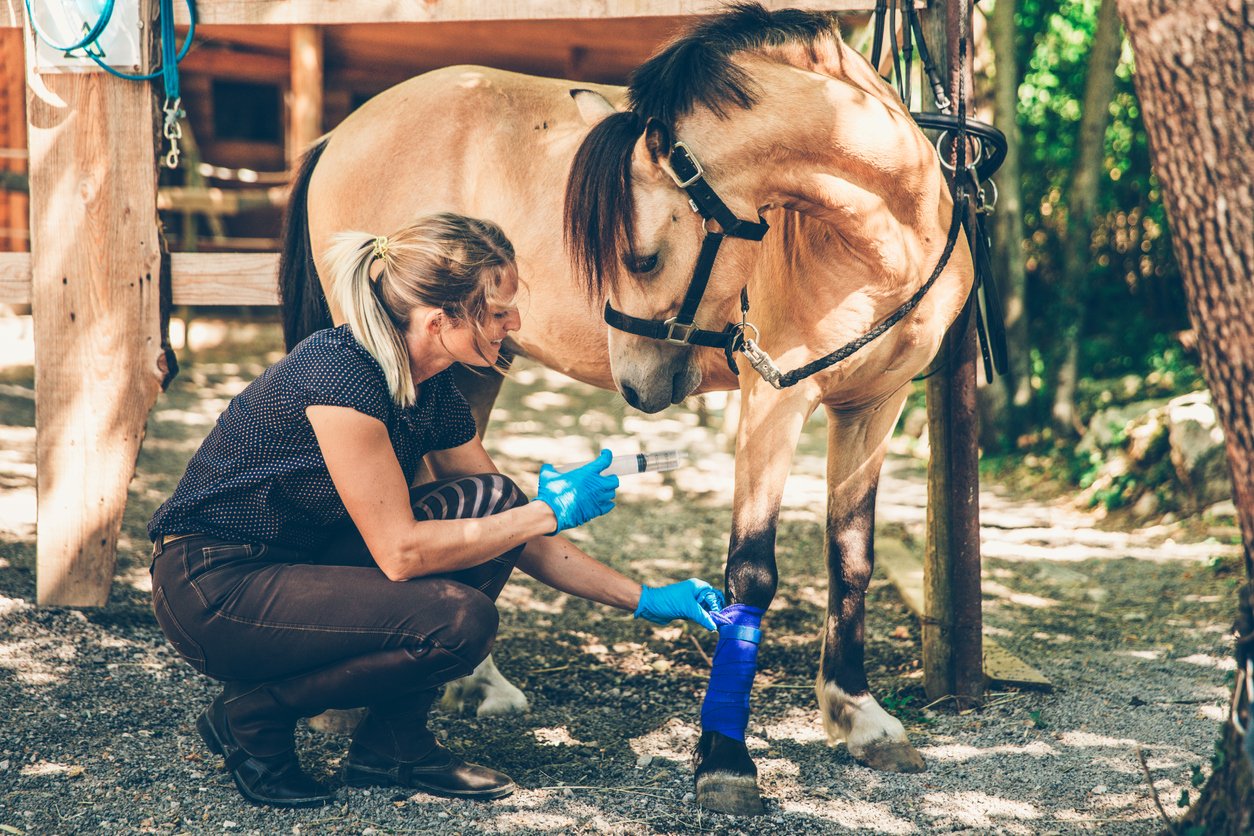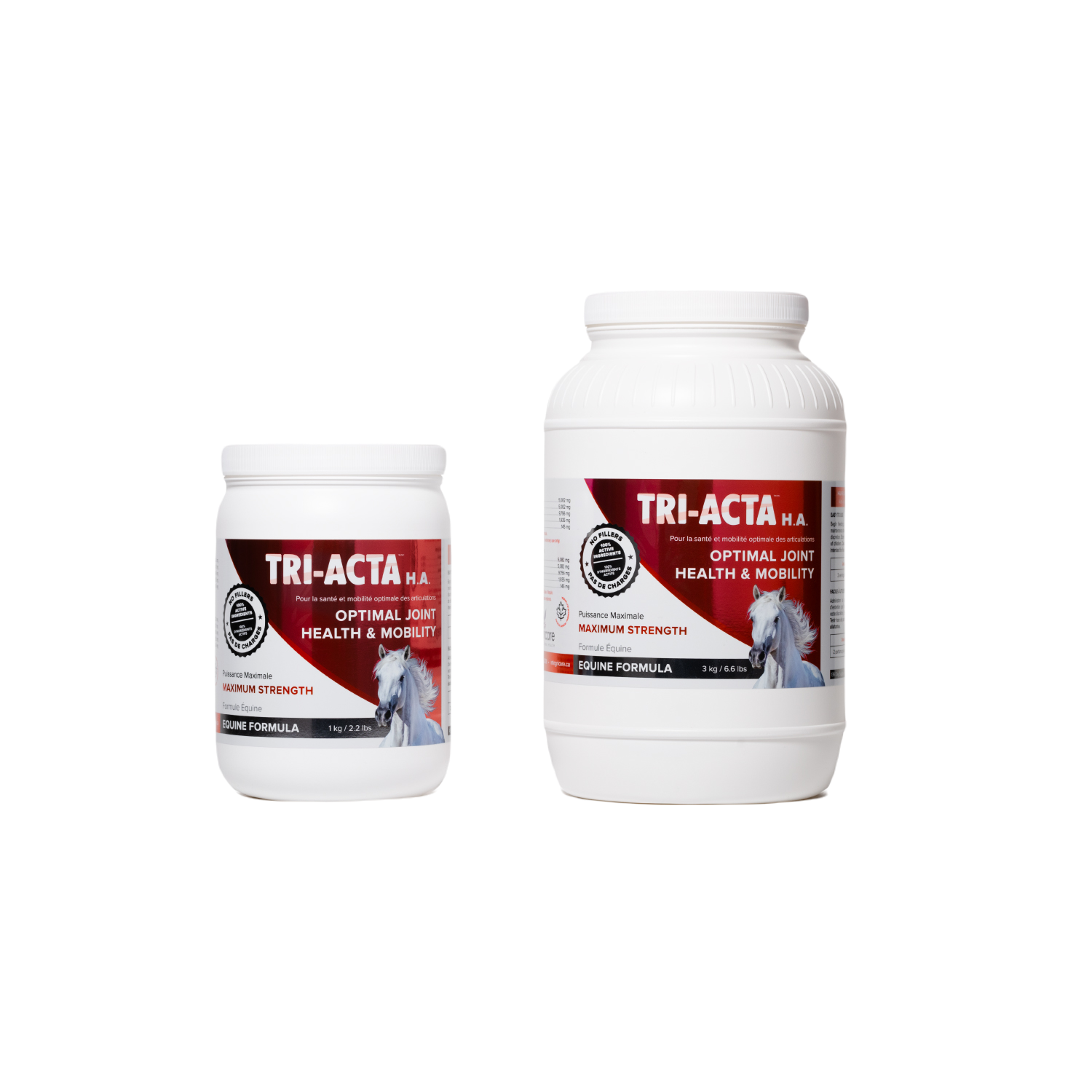Table of Contents
If your horse has a suspensory injury that means they've injured the tendons that run behind their legs and attach to their hooves. A quick burst of pain will tell them that something's wrong, but what is it? And what can you do to tackle an injury like this?
Let's talk about the causes, symptoms, and treatments for suspensory horse injuries so you know exactly what to do and how your horse will feel.
Suspensory Ligament Horse Anatomy
When we look at a horse’s body, we know there are plenty of unique structures working together to help your horse gallop, trot, and jump their way around the world. And one group of these systems is called the suspensory apparatus.
This hardworking, important group of structures includes:
- Suspensory ligament
- Proximal sesamoid bones
- Distal sesamoidean ligaments
The suspensory apparatus is part of the much bigger system in a horse’s legs called the “stay” apparatus. The diagram below shows a breakdown of this apparatus.
Think of this system as your horse’s natural parking brake. Through the “stay” apparatus, horses can stand at rest for hours at a time without exerting any muscles, thanks to anatomical structures in the fore and hindlimbs that provide passive resistance to joint flexion.
But what role does the suspensory horse ligament play in this nifty function? And what is it?
Horses' suspensory ligaments are strong bands of tendon-like tissue that run along the back of the cannon bone between the splint bones. They originate from the top of the back of the cannon bone and extend to the base of the fetlock.
Around the middle of the cannon bone, the suspensory ligament divides into two sections:
- Medial
- Lateral
The branches insert into the paired (lateral and medial) proximal sesamoid bones. In the weight-bearing and stance phases of the stride, the suspensory ligament prevents excessive extension of the fetlock joint.
What is Horse Suspensory Injury?
Now that you know just how important the suspensory ligament horse is, you’re probably wondering what exactly a horse's suspensory injury is. This serious but common injury makes up more than 46% of reported horse injuries.
A horse suspensory injury can be described as a variety of injuries to the suspensory ligament, ranging from mild or severe. They can be caused by various activities or scenarios, but risk factors can make your pony more susceptible to a suspensory horse injury.
These scenarios and risk factors for suspensory horse injury include:
|
Risk Factor for Suspensory Horse Injury |
Description |
|
Participation in Sport |
|
|
Conformation Issues |
|
|
Muscle Loss |
|
|
Improper Training |
|
Suspensory Ligament Horse Symptoms
Watching for the signs of this condition are critical to the outcomes of your horse’s health, as these injuries are common, and they can cause serious lame horse signs.
If your horse has hurt this critical ligament, you could notice one or more of the following suspensory ligament injury horse symptoms:
- Swelling
- Affected area is hot to the touch
- Sudden lameness
- Reluctance to work or move
If you notice any of these symptoms, it's important to have your horse seen by the veterinarian immediately. They will be able to diagnose and treat the injury properly so that it heals properly and completely.
Causes of Suspensory Injury in Horse

You can probably identify with this scenario: you're out riding your horse, and everything seems to be going fine. You approach a jump, and your horse takes off, suddenly crashing down as if they lost all ability to walk on their own two feet.
The suspensory ligament apparatus is located at the back of each leg, where they join with the pelvis (sacrum). These ligaments help stabilize the joints in your horse's back legs so when they're injured, it can affect his balance and coordination when jumping or doing other fast movements that require quick reactions from both rider and horse alike.
But this sudden injury is just one cause of suspensory injury in horses.
There are in fact three primary causes of suspensory injury in horses:
- Singular traumatic injury (like the one we described above)
- Repetitive strain injuries that occur over time are caused by excessive stress being placed on certain areas during repetitive actions performed by our four-legged friends
- Chronic degeneration of these tendons due to aging processes, which can be exacerbated by poor conformation
It's important to note that not all cases of horse suspensory injury are the same, so it's important to see your veterinarian if you suspect your horse has this condition. Your vet will conduct a thorough exam and may also take X-rays or ultrasound images of the affected area in order to determine the cause of the problem before deciding on a course of treatment for your horse.
Suspensory Horse Injury Treatment Options
There are plenty of minimally invasive techniques for managing suspensory horse injury problems.
These include suspensory horse injury treatment options such as:
- Medical management techniques
- NSAIDs
- Suspensory ligament surgery for horses
Your veterinarian will be able to help you determine the best course of treatment for your particular situation but let’s get familiarized with the options, so you know what to expect in advance.
Option #1: Non-Medical Management
Physical therapy and physical aids like icing, corrective shoes, supplements, and physical therapy can be the most helpful medical management techniques for horses with less severe cases of suspensory horse injuries. You can use various tools to reduce pain and help your horse feel better.
Some options for less severe cases of suspensory horse injury are outlined in the table below.
|
Management Tool |
How it Works |
|
Can reduce swelling and pain while helping to control the inflammation that causes some lamenesses. |
|
|
Lessens tension on the damaged ligament by raising the horse's heel, preventing weight-bearing forces from being transmitted along this joint structure while it is injured and weakened. |
|
|
Supplements like TRI-ACTA for equine |
Help rebuild and repair cartilage in those areas where they were injured and will also help decrease inflammation and pain during recovery. |
|
Helps your horse avoid stiffness and assists in strengthening their muscles after an injury has occurred. |
All these combined therapies can lead to a better recovery and more positive longer-term outcomes for your horse. But by far, the most important element in your horse’s management plan is rest.
Rest is still considered the best way to ensure the horse suspensory injury clears up but when combined with these other treatments it can be a powerful tool if you want them back sooner rather than later.
Option #2: Medicine
NSAIDs, or non-steroidal anti-inflammatory drugs, are a type of medication that can be used to treat inflammation and swelling. These medications are typically given by injection or by oral ingestion.
There are several different NSAIDs that are commonly used in horses, including:
- Phenylbutazone (“Bute”)
- Flunixin
- Naproxen
- Ketoprofen
- Meclofenamic acid
- Firocoxib
These medications can be powerful tools your vet can use as immediate treatment for the discomfort your horse is experiencing.
But, it’s important to remember that not all horses respond well to NSAIDs.
In fact, some horses have adverse reactions to them, so it’s important for your veterinarian to monitor the dosage closely and make adjustments as necessary. Side effects include diarrhea and ulcers in the stomach lining which can lead to stomach pain and bleeding if left untreated long enough.
You should also never give your horse a medication that has not been prescribed by your vet as horses have complex systems and need careful medical management by professionals.
Option #3: Surgery
Suspensory ligament surgery is the third option for treating suspensory ligament injuries.
During this procedure, a veterinarian will surgically remove a portion of the deep branch of the lateral plantar nerve that supplies the proximal suspensory ligament. This usually involves cutting open the back side of your horse’s front leg to access the suspensory ligament, depending on where the injury is located.
As with other types of surgery for horses, there are risks associated with suspensory ligament surgery, and it is usually only considered for very serious cases. That said, there are definitive benefits to having your horse undergo this surgery in the long run, too.
Check out the table below to weigh the risks and benefits of this procedure.
|
Risks |
|
|
Benefits |
|
The best way to ensure a smooth recovery is to follow post-operative procedures provided by your vet, which may include medication plans and wound care, as well as rest instructions.
Something else to add to your horse’s post-op recovery? A powerful, extra-strength joint supplement like TRI-ACTA H.A. for equine. With the inclusion of hyaluronic acid, this horse joint supplement is ideal for helping your horse heal from the inside out and improve their recovery time. The power of H.A. alongside chondroitin, glucosamine for horses, and MSM combat inflammation, repair cartilage, and stop it from breaking down further—perfect for helping your horse get back on their hooves in no time!
TRI-ACTA H.A. for Equine
Our maximum strength formula is perfect for horses that are ageing, experiencing arthritis and stiffness, are in training and competition, or under a heavy workload.

If you’re unsure whether or not your horse would benefit from this type of surgery, talk to your veterinarian about their opinion on the matter.
Q&A
You have questions about suspensory horse injuries, and we’ve got answers! Let’s get into some of the most commonly asked questions about suspensory horse injuries, so you’re better prepared to face this condition.
Where Is the Suspensory Ligament on a Horse?
The suspensory ligament is a strong ligament in your horse’s limbs that plays an important role in their motion. Beginning at the knee or hock, it runs down the cannon bone, branches around the fetlock, and attaches to the sesamoid bone. During movement, a horse's suspensory ligament prevents the fetlock joint from descending too far.
A suspensory injury occurs when this important band of tissue becomes strained or ruptures, causing your horse great pain and discomfort. In some cases, a complete rupture can occur and leave your horse unable to work for several months or even permanently disabled if left untreated. However, most sports medicine experts recommend surgery as soon as possible following an acute injury to prevent permanent damage from occurring.
Can a Horse Recover From a Suspensory Ligament Injury?
It is possible for horses to recover from suspensory injuries. However, it can take a long time, and sometimes the horse will never fully recover. It also depends on the treatments used. Some horse suspensory treatments can have up to an 85% recovery rate, while others may only help about half of the patients in the long term.
In some cases, horses appear to be much better after resting and treatment, but the lameness reappears shortly after being put back to work. This can be incredibly frustrating for owners who have cared for their animals properly and feel they have done everything right during recovery.
The best thing you can do when this happens is to consult your vet so that they can evaluate your horse's lameness again as well as any other symptoms that may be present (such as swelling in the affected leg). If there is anything else going on with your horse’s health that could impede its return from suspensory injury (for example, colic) then this should also be addressed simultaneously by a veterinarian before returning your horse back to work or competition.
Are Horse Boots Effective for Suspensory Support?
Injuries to the suspensory ligament are serious and can be life-threatening if not handled properly. As a horse owner, it is important to know what signs of suspensory injury your horse may show and how you can help prevent them from happening in the first place. Horse boots for suspensory support are designed to protect your animal's leg during recovery from an injury, and they should also fit comfortably so that your horse pal isn't uncomfortable.
If you think your horse has sustained an injury or might be prone to one, consult a veterinarian about how best to proceed.
Closing Thoughts

Suspensory injuries can be very painful and take a long time to heal. However, there are ways to help your horse recover more quickly.
Take care not to overwork your horse while they are still healing from a suspensory injury. It’s also important to make sure they stay as comfortable as possible during this time by providing them with plenty of room to rest. If you see signs of infection such as redness around the area where the injury occurred then contact your veterinarian immediately for treatment advice—do not wait until symptoms worsen because this could lead to more serious problems down the road like sepsis.
And one of the best compliments to rest is adding a joint supplement like Integricare's family of equine joint care products. Whether your horse is recovering from a mild injury or recovering from suspensory horse injury surgery, there's neigh doubt about it – TRI-ACTA and TRI-ACTA H.A. for equine are both excellent options for relieving the pain and discomfort associated with suspensory horse injury.
TRI-ACTA H.A. for Equine
Our maximum strength formula is perfect for horses that are ageing, experiencing arthritis and stiffness, are in training and competition, or under a heavy workload.

Newsletter Signup
Subscribe to our newsletter to receive the latest news and exclusive offers.
.jpg?height=2000&name=Cliick_Integricare-DISPLAY-REVISEDV2%20(1).jpg)
Proactive & Therapeutic Joint Supplements
When given daily, Integricare joint supplements recover bone and joint injuries faster and help prevent mobility injuries from happening in the first place.









